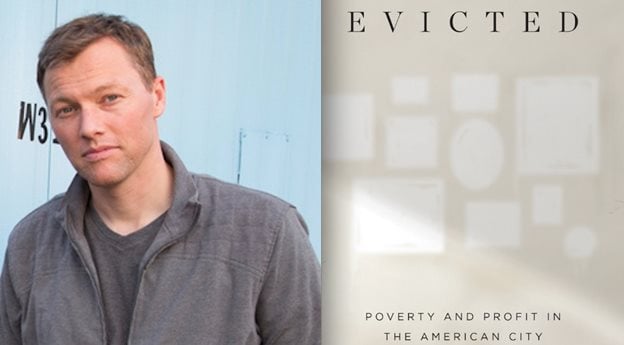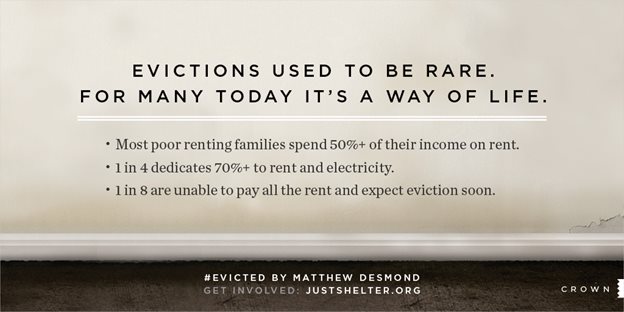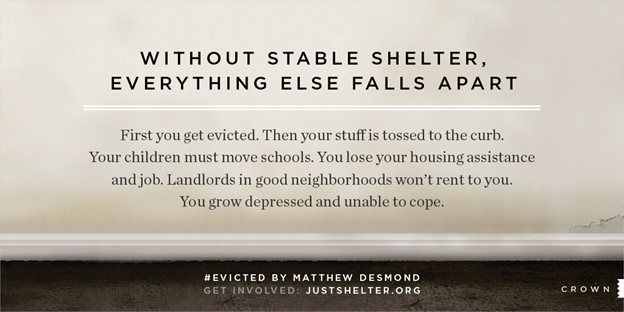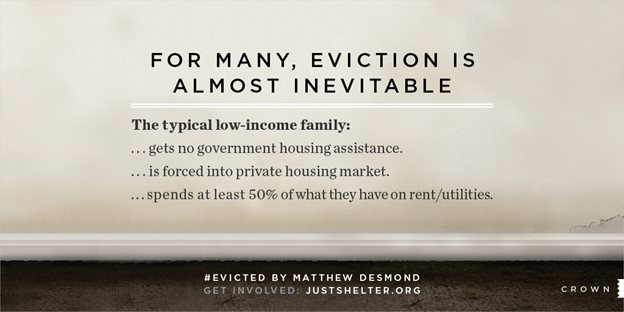In an era when it seems fewer and fewer people are reading anything longer or “deeper” than social media posts and “7-reasons-to” lists, it is somewhat shocking that a 336-page, nonfiction book on evictions written by a Harvard professor would be on best-seller lists. Even Buzzfeed, the king of those easily digested list posts, heralded the new book as one of the “hottest” in 2016.

For NeighborWorks America and its network, as well as every other nonprofit organization focused on assuring that affordable housing options are available to everyone, “Evicted: Poverty and Profit in the American City” is a remarkable documentation of the critical importance of our work. Although the lens through which author Matthew Desmond conducted his ethnographic research is the “revolving-door” eviction of the very poor from rental properties, his bottom-line conclusions communicate the critical importance of affordable housing in all of its forms.
“The problems endemic to poverty—residential instability, severe deprivation, concentrated neighborhood disadvantage, health disparities, even joblessness—stem from the lack of affordable housing,” writes Desmond, an associate professor of sociology and social science at Harvard and codirector of the Justice and Poverty Project. “What else is a nation but a patchwork of cities and towns; cities and towns a patchwork of neighborhoods; and neighborhoods a patchwork of homes? America is supposed to be a place where you can better yourself, your family and your community. But this is only possible if you have a stable home.”
Desmond—whose sensitivity to the importance of “home” began in undergraduate school, when he helped his parents move after they lost the family house to foreclosure—conducted his extensive field research in the city of Milwaukee. He describes the city as “a fairly typical midsize metropolitan area with a fairly typical socioeconomic profile and housing market and renter protections.” He validated his findings with available statistics from a cohort of other cities, as well as national data.
Eviction is reality of life for poor renters
In many ways, his book breaks new ground. “Eviction,” he writes, “is one of the least-studied processes affecting the lives of poor families.” And yet, it is tragically common: In 2013, 1 in 8 poor renting families nationwide was unable to pay all of their rent, and a similar number thought it was likely they would be evicted soon. Between 2009 and 2011, says Desmond, roughly a quarter of all moves by Milwaukee’s poorest renters were involuntary.
Desmond chose to study eviction because, he says, “I wanted to try to write a book about poverty that didn’t focus exclusively on poor people or poor places,” he explains at the conclusion of the book. (If you don’t read all of it, do not skip the last chapter, “About This Project.” In fact, if you read nothing else, read that and the epilogue.) “Poverty is a relationship, involving poor and rich people alike. This sent me searching for a process that bound poor and rich people together in mutual dependence and struggle. Eviction is such a process.”
The “rich people” he references are the private, for-profit landlords who have discovered there is a lot of money to be made off of the poor. In fact, he takes pains to highlight the fact that by fixating almost exclusively on what poor people and their communities lack, “we have neglected the critical ways that exploitation contributes to the persistence of poverty.” What a resounding endorsement of the need for the NeighborWorks network and nonprofits with similar missions. In addition to working to expand the supply of rental housing affordable to low-income families and individuals, many of our members have specific programs in place to avoid evictions, as well as resident services that support struggling tenants in other ways.
What also makes Desmond’s research so compelling—particularly for the broader, lay community—is the fact that he actually lived with or among the people he writes about. In 2008, for instance, he moved into the trailer park that features prominently among his stories. The investment allowed Desmond to put people at the center of the messages he wanted to convey, in a fashion that made them jump off the pages in living color. The fact that he was faithful to their warts as well as their often hidden beauty, tenants and landlords alike, makes the book highly credible even to those with different viewpoints. That is an important lesson for all nonprofits in this space that struggle to wins hearts, minds—and pocketbooks.
Eviction is cause of poverty
The consequences of eviction are common knowledge, but Desmond documents them in a comprehensive fashion that did not exist previously. I know, because when I wrote a blog post about eviction-prevention programming among nonprofits, including NeighborWorks members, I had a hard time rounding them up. Here are just a few:- The likelihood of being laid off is roughly 15 percent higher for workers who have experienced an eviction.
- The year after eviction, families experience 20 percent higher levels of material hardship than similar families who were not evicted. And it persists at least two years afterward.
- One in two recently evicted mothers report multiple symptoms of clinical depression, double the rates of similar mothers who were not forced from their homes. In fact, a group of psychiatrists published a letter in Psychiatric Services identifying eviction—which they called “an exquisitely shameful experience”—as a significant precursor of suicide.

“Eviction fundamentally redirects poor families, casting them onto a different, and much more difficult, path,” concludes Desmond. “Eviction is a cause, not just a condition, of poverty.”
Unfortunately, like so many other blemishes in American life, evictions also are more concentrated among minorities, particularly blacks. Among Milwaukee renters, more than 1 in 5 black women report having been evicted in their adult lives, compared to 1 in 12 Hispanic and 1 in 15 white women.
Even critics who blame evictions on lazy, irresponsible or ill-informed renters should want to find ways to prevent them that are more effective than just kicking them out. As Desmond documents, most evicted households have children living in them--“leaving a deep and jagged scar on the next generation.” In addition, a single eviction can destabilize multiple city blocks.
Is there a solution?
So what is the answer? Clearly, it’s not as simple as controlling rents or banning evictions, even if that was possible in our political environment. After all, even mission-oriented nonprofits like those in our network, who are committed to helping people of all incomes find and stay in affordable housing, cannot afford to offer homes rent-free. Rents sufficient for developers and property manager to stay in operation must be collected from someone.Desmond advocates a universal housing voucher program in which the renting household contributes 30 percent of its income, as well as rent controls so taxpayers don’t subsidize landlords’ profits. Those are policy options beyond NeighborWorks’ purview. However, the solution clearly also includes more resources for more affordable housing—a mission we share. (It’s good news that HUD recently debuted a modest fund to finance housing for the very poorest residents in America, called the National Housing Trust Fund.)
Part of the solution also must be working to prevent evictions as much as possible. As highlighted in this blog post, many of our members have found cost-effective ways to intervene early when a tenant is in trouble to prevent eviction. They include financial coaching and education to build skills that will benefit families and individuals achieve much more than just stable housing.
Sometimes, however, emergency funds are needed, which is why too many low-income people turn to predatory services such as payday lending. There are few resources to help fill those breaches, which is why some nonprofits, such as NeighborWorks member Kennebec Valley Community Action Program, have partnered with others to offer just such a fund.
It also might mean, says Desmond, deciding who to approve as tenants on a more case-by-case basis, instead of automatically refusing them due to a past eviction. It’s interesting to note that although the majority of evictions are due to nonpayment or late rent, the presence of children also often triggers an eviction. Fearing street violence, many parents in crime-ridden neighborhoods keep their children locked inside. Children cooped up in small apartments do things like use the curtains for superhero capes, flush toys down the toilet and drive up the water bill. Children also may test positive for lead poisoning, which could bring landlords a pricey abatement order. The result: eviction. The presence of children in a household, says Desmond, almost triples a tenant’s odds of being evicted. In fact, the effect of living with children is equivalent to falling four months behind on rent, he writes.

Another contributor to evictions is an abusive husband or boyfriend. When women call 911 seeking help, resulting in a police report, landlords often resort to eviction due to nuisance property ordinances that allow police departments to penalize landlords for the behavior of their tenants. A woman reporting domestic violence is far more likely to land her landlord a nuisance citation if she lives in the inner city. In 83 percent of the cases, landlords respond by evicting or threatening to evict.
“The persistence and brutality of American poverty can be disheartening,” concludes Desmond, “leaving us cynical about solutions. But as Scott [one of the residents he writes about] will tell you, a good home can serve as the sturdiest of footholds. When people have a place to live, they become better parents, workers and citizens.”
Scott, a drug-addicted former nurse who lived in the trailer park in which Desmond lived, is a beacon of hope—proof that what we do works. With the help of a drug-rehabilitation program that also provided housing, he now is on the road to earning back his nursing certification.
Scott’s apartment had clean carpeting, unblemished white walls, mini blinds over person-length windows, a generous bathroom, and a working stove and refrigerator. It rented for $775 a month, but he was required to pay only $141. “It took a month before Scott was able to accept the apartment as his own. Once he did, he acquired a bathroom rug, a coverlet and all of the other trappings needed to feel he belonged. The apartment made Scott feel affirmed, deserving of something better.” When Desmond visited next, Scott had taped a five-year plan to the refrigerator.
Can you imagine any better proof of the importance a safe, healthy, affordable home can make?

